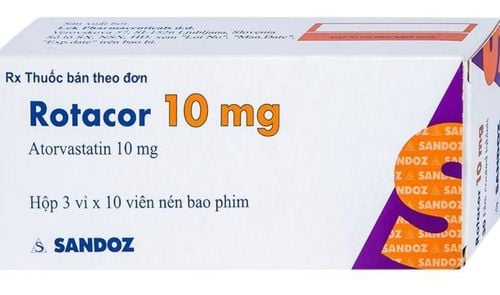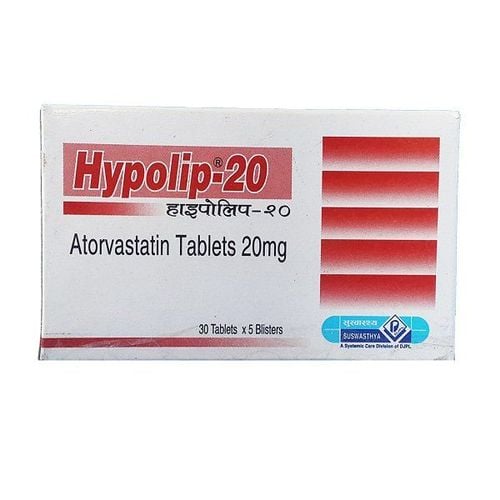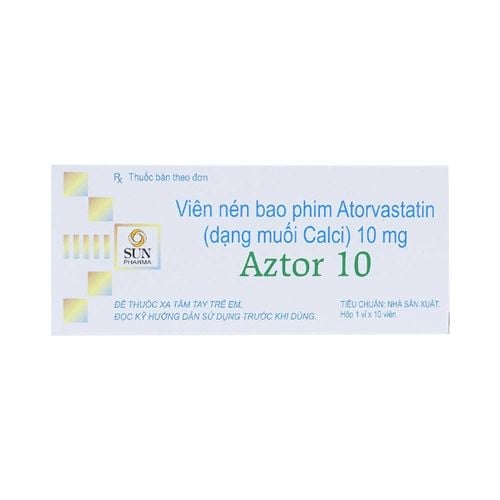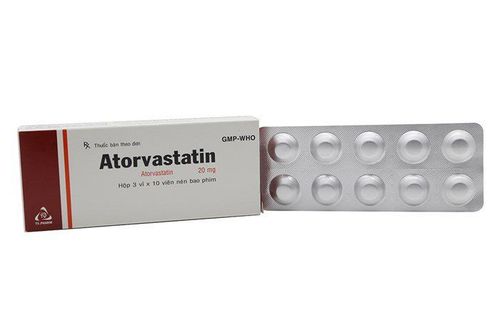This is an automatically translated article.
Bonzacim 10mg is often indicated as a supplement to the diet to reduce total cholesterol in patients with dyslipidemia. So to find out specifically what Bonzacim is? how does it use? Let's find out the necessary information about the use of Bonzacim 10mg through the article below.
1. What is Bonzacim?
Bonzacim 10mg drug manufactured by Celogen Pharma company - India, the main ingredient is Rosuvastatin calcium. Bonzacim 10mg is formulated as a film-coated tablet, and is currently a competitive product at a reasonable price compared to other products with the same active ingredient. Bonzacim 10mg is a prescription drug used to treat dyslipidemia, hypercholesterolemia and prevent possible cardiovascular events.
2. Uses of Bonzacim 10mg
Rosuvastatin is a fully synthetic statin that reduces blood cholesterol by competitively and selectively inhibiting the enzyme HMG-CoA reductase. It is an enzyme involved in the conversion of 3-hydroxy-3-methylglutaryl coenzyme A to mevalonate, a precursor of cholesterol.The target of rosuvastatin is the liver. Rosuvastatin lowers LDL-cholesterol, total cholesterol, triglycerides and increases HDL-cholesterol by increasing the number of hepatic LDL receptors on the cell surface, enhancing absorption and catabolism of LDL, thereby inhibiting inhibition of VLDL synthesis in the liver leads to a decrease in VLDL and LDL particles.
The effectiveness of Rosuvastatin is achieved after 1 week of treatment and 90% of patients have a response after 2 weeks of use.
Bonzacim 10 is indicated for use in the following cases:
Supplement to the diet to reduce total cholesterol, LDL-C, ApoB, nonHDL-C, triglycerides and increase HDL-C in patients with primary hypercholesterolemia (heterozygous with and without familial) and mixed dyslipidemia (Fedridkson groups II a and II b). Dietary supplement for the treatment of patients with elevated triglyceride levels (Fredickson group IV). Lowering total cholesterol, LDL-C and ApoB in people with homozygous familial hypercholesterolemia, as an adjunct to other lipid-lowering therapy (eg, LDL-C dialysis) or when these methods are not available. effective.
3. How to use Bonzacim 10mg
3.1. How to take Bonzacim 10mg Before being treated with the drug, the patient should develop a standard cholesterol-lowering diet and continue to do so throughout the course of drug treatment.
Bonzacim used orally, drink with filtered water. Patients can take it at any time of the day, with or without meals.
3.2. Dosage of Bonzacim 10mg Take rosuvastatin daily from 5 to 40mg. Dosage should be individualized based on the goal of treatment and the patient's response. The recommended starting dose is 10mg per day. But for people who don't need much LDL-C reduction or who may have risk factors for myopathy, it's a good idea to start with a dose of 5mg daily.
After initiation or titration of rosuvastatin, blood lipids should be analyzed in 2-4 weeks and dosage adjusted accordingly.
Children
Safety and effectiveness in children have not been established. Experience in pediatric use is limited to a limited number of children (8 years of age or older) with homozygous familial hypercholesterolemia. Therefore, rosuvastatin should not be given to children.
Elderly
An initial dose of 5 mg is used in patients > 70 years of age. No dose adjustment is required in these patients.
Patients with renal impairment
No dose adjustment is required in patients with mild to moderate renal impairment. Patients with moderate renal impairment (creatinine clearance < 60 ml/min) are recommended to start with 5 mg, but 40 mg is contraindicated. The use of rosuvastatin is contraindicated in patients with severe renal impairment (creatinine clearance < 30 ml/min).
Recommended dosage when co-administered with HIV and HCV protease inhibitors
Interacting protease inhibitors:
Atazanavir . Lopinavir + ritonavir. Atazanavir + ritonavir. Prescribing recommendations: Limit the dose of rosuvastatin to a maximum of 10 mg once daily.
Note: The above dosage is for reference only. The specific dose depends on the condition and the progression of the disease. To get the right dose, you need to consult your doctor or healthcare professional.
4. Contraindications of Bonzacim 10mg
Hypersensitivity to drug components. Liver disease develops including unexplained persistent elevations in serum transaminases, and when transaminases are elevated more than 3 times the upper limit of normal. Severe kidney failure. Muscle disease. Taking cyclosporine. Pregnant or breastfeeding women can become pregnant without using appropriate contraception.
5. Notes when using Bonzacim 10mg
5.1. Precautions before treatment with Bonzacim Before starting treatment with Bonzacim, it is necessary to rule out causes of hypercholesterolemia (eg, poorly controlled diabetes, hypothyroidism, nephrotic syndrome, dysproteinemias). , obstructive liver disease, use of certain other drugs, alcoholism) and need to measure total cholesterol, LDL cholesterol, HDL cholesterol and triglycerides.
Lipid measurements should be performed periodically, at intervals of not less than 4 weeks, and dosage adjusted according to the patient's response to the drug. The goal of treatment is to lower LDL cholesterol, so LDL cholesterol levels should be used to initiate treatment and assess response to treatment. Only when LDL cholesterol cannot be tested should total cholesterol be used to monitor treatment.
Consideration should be given to the use of statin drugs in patients with risk factors for muscle damage. It is necessary to closely monitor for adverse reactions during drug administration.
Consider creatine kinase (CK) monitoring in the following cases: Before starting treatment, a CK test should be performed in the following cases: Renal impairment, hypothyroidism, personal or family history of the disease hereditary myopathy, history of myopathy due to previous statin or fibrate use, history of liver disease or heavy alcohol consumption, elderly patients (>70 years) with risk factors for rhabdomyolysis, likelihood drug interactions and some special patients.
In these cases, the benefits and risks should be weighed and the patient monitored clinically during statin therapy. If CK test results are > 5 times the upper limit of normal, statin therapy should not be initiated.
During statin treatment, patients need to report when there are muscle symptoms such as muscle pain, muscle stiffness, muscle weakness... When these symptoms are present, the patient needs to do a CK test to get the symptoms. appropriate interventions.
Liver enzyme tests should be performed prior to initiating statin therapy and in cases of clinical indications requiring subsequent testing.
Administration of 20 mg rosuvastatin to subjects with severe renal impairment (CLcr < 30 ml/min/1.73 m2) resulted in a 3-fold increase in rosuvastatin plasma concentrations compared with healthy volunteers.
5.2. Ability to drive and use machines The drug does not affect the ability to drive and use machines.
5.3. Pregnancy Safety in pregnant women has not been established, so the drug should be used during pregnancy only when the desired effect outweighs the harm caused by the drug.
Therefore contraindicated for pregnant women, women of childbearing potential but not using appropriate methods of contraception.
5.4. Lactation A small amount of the drug passes into breast milk. Because the drug has the ability to inhibit HMG-CoA reductase, it can seriously affect a nursing infant.
Therefore contraindicated for women who are breastfeeding.
6. Side effects of Bonzacim 10mg
Adverse reactions reported with Rosuvastatin were generally mild and transient. In controlled clinical studies, less than 4% of Rosuvastatin-treated patients withdrew due to an adverse event. The following are some of the side effects of Bonzacim 10mg:
Immune system disorders Rare: hypersensitivity reactions including angioedema. Nervous system disorders Common: headache, dizziness. Digestive system disorders Common: constipation, nausea, abdominal pain. Skin and subcutaneous tissue disorders Uncommon: pruritus, rash and urticaria. Musculoskeletal, connective tissue and bone disorders Common: myalgia. Rare: myopathy, rhabdomyolysis. General disorders: Common: asthenia. As with other HMG-CoA reductase inhibitors, the frequency of adverse reactions tends to be dose dependent with Bonzacim 10 mg.
Renal effects: Proteinuria, detectable by dipstick and of primary tubular origin, has been reported in patients treated with Rosuvastatin. A change in proteinuria from no or only trace to positive ++ or greater has been observed in < 1% of patients treated with Rosuvastatin 10 mg and 20 mg and in approximately 3% of patients treated with Rosuvastatin. 40mg. A slight increase in proteinuria from no or trace to positive was observed at the 20 mg dose. In most cases, proteinuria decreased or resolved spontaneously with continued treatment and was not a precursor of acute or progressive kidney disease. Effects on the musculoskeletal system: Like other HMG-CoA reductase inhibitors, musculoskeletal effects such as myalgia and myopathy are uncomplicated and very rarely rhabdomyolysis, sometimes with An association with impaired renal function has been reported in patients treated with Rosuvastatin. Dose increases in CK concentrations were also observed in a small number of patients receiving rosuvastatin; Most cases are mild, asymptomatic and transient. If CK levels are elevated (>5xULN), treatment should be temporarily discontinued.
Hepatic effects: As with other HMG-CoA reductase inhibitors, dose-related increases in transaminases have been observed in a small number of patients receiving rosuvastatin; Most cases are mild, asymptomatic and transient.
7. How to store Bonzacim 10mg
Bonzacim 10mg medicine is stored in a cool, dry place, away from direct light.
Please dial HOTLINE for more information or register for an appointment HERE. Download MyVinmec app to make appointments faster and to manage your bookings easily.













